OK, so we’ve got this interplay of animals and machines in Dumbo. We’ve got Akira Lippit’s assertion that animals show up in early cartoons as “a gesture of mourning for the disappearing wildlife” (Electric Animal, p. 196); we’ve got the locomotive, Casey Jones, Jr. puffing “I think I can, I think I can” as it goes up the mountain; and we’ve got pink elephants transforming themselves into cars.
I want to do a bit more thinking about this dialectic of animals and machines. Most generally machines present humans with three problems:
1) A metaphysical problem.2) A common sense problem.3) A a problem of social organization.
Let’s run through them in order and so how, of if, they show up in Dumbo.
Machines as Metaphysical Problem
The metaphysical problem was set by Descartes, Leibniz and others and is still with us. In its deepest form it involves specialized and often technical discussions that are mostly the province of specialized and learned intellectuals, though it does filter down to the common world. As such it doesn’t translate well into films, where robots and computers come across as strange kinds of people. That is, the metaphysical problem becomes expressed as the common sense problem.
Dumbo doesn’t deal with this issue at all. But the common sense world is another matter.
Machines in the Common Sense World
The common sense problem is simply that of living in a world where there are machines. To someone born and raised in the world of machines they present no more, and no less, of a problem than plants, animals, humans, and all sorts of man-made things. To someone born and raised in a world without machines, they DO present a problem: how does one comprehend and deal with these strange things?
So, imagine that you reached adulthood without ever having seen a car or an automobile. You’re used to seeing humans and animals move across the land and you’re used to seeing them pull carts and wagons. How do you react the first time you see a railroad train? How do you make sense of what appears to be a thoroughly artificial device moving over the land under its own power? It doesn’t make sense. Animals can move, but this isn’t an animal. It’s a machine. You can see the parts, the levers and the wheels, you can see the smoke coming out of the fire box. But there’s no flesh there. It’s a bit spooky, no? There’s no ready-made place for such a thing in your conceptual system.
And so we have Henry David Thoreau writing this at the middle of the 19th century (Walden, 1854):
When I meet the engine with its train of cars moving off with planetary motion . . . with its steam cloud like a banner streaming behind in gold and silver wreaths . . . as if this traveling demigod, this cloud-compeller, would ere long take the sunset sky for the livery of his train; when I hear the iron horse make the hills echo with his snort like thunder, shaking the earth with his feet, and breathing fire and smoke from his nostrils, (what kind of winged horse or fiery dragon they will put into the new Mythology I don’t know), it seems as if the earth had got a race now worthy to inhabit it.
Disney’s audience, of course, lived in a very different world from Thoreau’s. They grew up with trains and automobiles. These moving machines don’t present the Disney audience with this common sense problem. However, the anthropomorphic and metaphorical conceptual tropes that originated in the 19th century still persist. So it is common and ‘natural’ to anthropomorphize all kinds of machines, and cartoons commonly did and still do so.
Disney’s audience was also born and raised in an world with elephants. Elephants are animals, just like mice, dogs, horses, and bison. But they are not native to North America. They are thus exotic. They are, in that sense, much stranger than automobiles and steam locomotives. It’s almost as though, in identifying elephants with cars and locomotives as he does at the end of Pink Elephants, Disney is domesticating the elephant rather than naturalizing the car or the locomotive.
This is just the sort of trickery on which myth logic thrives, equating something that’s strange, but natural, the elephant, with something that’s familiar, but artificial, the car. Disney pushes the trick one step further at the end of the film when he identifies Dumbo with bombers. While airplanes were not new in 1941, they weren’t so familiar as cars and trains. Everyone knew about and had ridden in cars and trains, but relatively few had flown in an airplane. Airplanes were thus a bit exotic, like elephants. Now we’ve got an equation between something that’s both strange and natural, the elephant, with something that’s both strange and artificial, the airplane.
Of course, if elephants are strange in America at large, they’re not so strange within this little film, which is saturated with them. To borrow a term from Lippet, Disney has used the elephant as a semiotic facility (Electric Animal, p. 196). By making this strange beast into a familiar friend, Disney can then use it to naturalize technological artifice of even the most exotic kind.
Machines as a Problem of Social Organization
Then there’s machines as a problem of social organization, that of the mechanization and routinization of every day life, but especially of the work place. This is the domain of so-called “scientific management“, and that certainly WAS a problem in Disney’s world, certainly for his audience and, for that matter, for his employees, as Disney was relentless in his desire to break-down his process into distinct steps that could be parceled out to different workers.
The Fordist production line loomed large in the live of many in Disney’s audience and it certainly loomed large in the imagination. For example, it was central to Charlie Chaplin’s Modern Times, which came out in 1936, just a few years before Dumbo. And it remained salient for some time. There is, for example, the famous chocolate factory episode of I Love Lucy (1952) in which Lucy and Ethel take jobs in a candy factory and manage to all-but destroy a production line.
At first glance it would seem that there’s nothing like a production line in Dumbo. This is, after all, set in a circus, which is about a series of unique acts, not factory assembly. I note, however, that the film emphasizes the circus as a place of work for its employees, not as a source of entertainment for the audience. And there is that early tent raising sequence that depicts a kind of work that is repetitive. It’s not an assembly line, it’s not timed to a clock, but it IS work, and it is demanding.
Now, look at the beginning of the Pink Elephants sequence. First we see Dumbo blow a bubble that turns into a large pink elephant. And then we see this:
What is that if not the production of one elephant by another? That quickly gives way to repetitive imagery that dominates the early part of that sequence:
Nor is this the first time Disney’s given us this kind of relentlessly repetitive imagery. It was there in The Sorcerer’s Apprentice with the maniacally multiplying brooms:
Here’s what Nicholas Sammond says about that episode in Babes in Tomorrowland (2001, pp. 176-177):
It is not hard to in “The Sorcerer’s Apprentice” a tale about the anxiety attendant on regimes of scientific management, and the resolution of that anxiety through the their mastery. In the hands of the master, the magic derived from the book created illusions of beauty, which took the natural shape of butterflies. Left to his child—and Mickey was discursively constructed as Disney’s child—that magic became a dangerous, uncontrollable force that threatened to destroy the master’s work and everything with it...Mickey animates the broom and sets it to work doing a simple repetitive task. He dreams that he has control over the machinery of the universe but awakens to discover that he has set in motion a juggernaut of automation.
That situation comes to a happy end when the master returns and restores order. The scene in Dumbo is framed differently—a drunken dream rather than out-of-control magic—and it evolves differently. In fact, it evolves to a point where elephants decide to become cars. For if you look closely at that bit you’ll see that the pair of dancing elephants leaps into carhood rather that it being something that happens to them, like the original bubble was transformed into an elephant.
Now, let’s be clear, I’m not trying to argue that those repetitive elephants somehow stand for or symbolize an assembly line, nor do I think that Sammond is making a similar assertion about the brooms. Rather, we’re saying that the imagery in the Disney films has they same relentless repetitiveness that is characteristic of Fordist assembly lines and that that imagery gets its salience from the increasingly pervasive presence of assembly line work for people in Disney’s audience. Beyond that, Sammond is specifically interested in how Disney construes children (e.g. Mickey as the sorcerer’s son/apprentice) and the passage I quoted is in the general context of discussing the contemporary application of management techniques to raising children and managing the home.
With all that in mind, let’s look at the Wikipedia’s summary of the opening section of Chaplin’s Modern Times:
Modern Times portrays Chaplin as a factory worker employed on an assembly line. After being subjected to such indignities as being force-fed by a "modern" feeding machine and an accelerating assembly line where he screws nuts at an ever-increasing rate onto pieces of machinery, he suffers a mental breakdown that causes him to run amok, throwing the factory into chaos. Chaplin is sent to a hospital. Following his recovery, the now unemployed factory worker is mistakenly arrested as an instigator in a Communist demonstration.
So, Chaplin has a breakdown from factory work and ends up in the hospital. What do we see in the first sections of Pink Elephants? First, a bunch of pink elephants marching on and on, and then we see a non-pink elephant in a hospital and looking horrified.
Of course, I’m not arguing that Disney’s team had Modern Times in mind when they designed and executed this sequence, though they must have known the film. I’m simply noting a general pattern similarity a suggesting that it was “in the cultural air” at the time. And remember, when Dumbo was being made, tensions within the company were building to the point of many of the workers going out on strike.
I take it, then, that the machine as a problem in social organization is very much a concern in this film, which also deals with the oppressive and self-serving ways of management in the person of the ringmaster. However, the burden of the “argument” about ‘scientific’ management has been displaced from the workplace itself and into the oddest and least “natural” sequence in the film, the Pink Elephants sequence. In Fantasia Fordism was packaged as magic gone amuck while in Dumbo it has been packaged as a drunken delusion.
In Dumbo, that drunken delusion ultimately lead to success. But a discussion of that would require a discussion of the whole film. I’m not yet ready for that.
Elephants, the Circus, and Myth Logic
Here’s what we’ve got: Dumbo is a film about an exotic kind of animal, the elephant, that is set in an exotic kind of work place, the circus. The exotic animal is used to domesticate the machine and the exotic workplace is used to domesticate factory work. Such are the peculiar workings of myth logic.
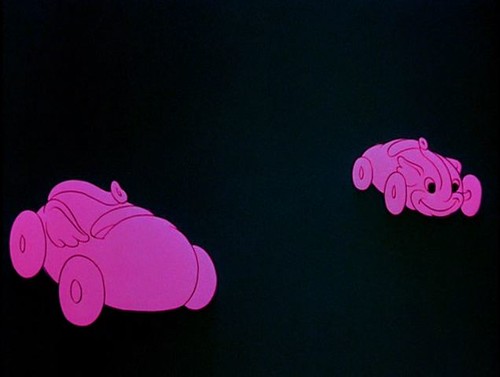

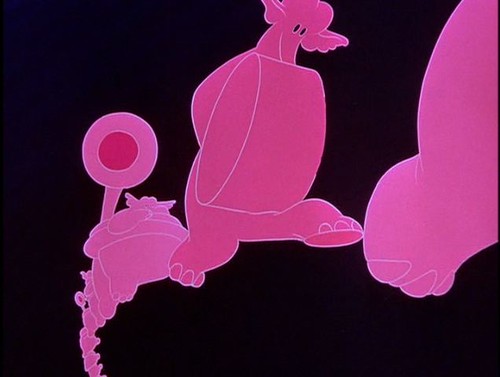
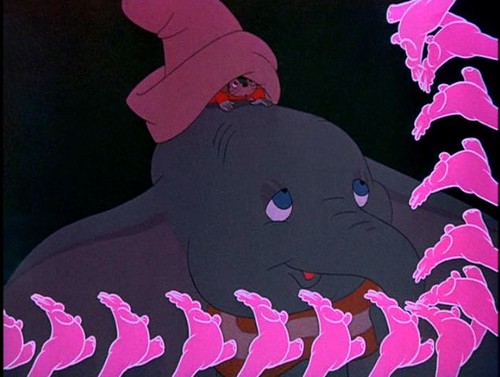
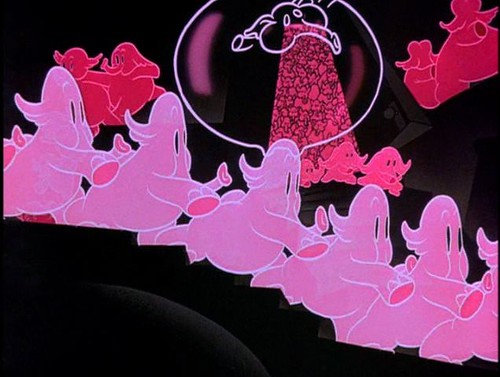

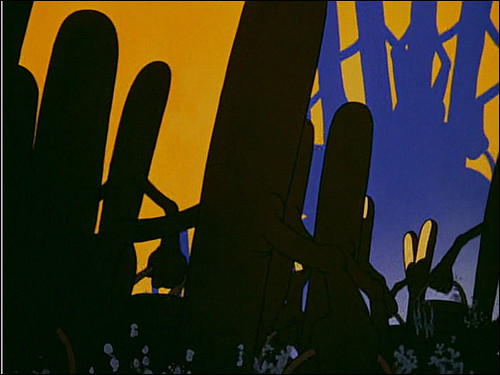
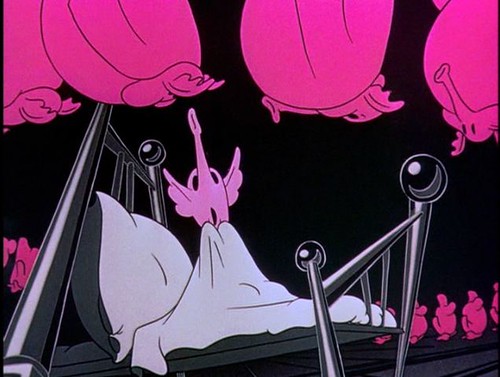
Nice.
ReplyDeleteNot seen the film since I was a kid so not a direct comment.
Years ago did some work on reactions farm workers had to steam engines first arriving on the farm.
Fear and terror of the object itself on first encounter, caused serious anxiety. Generally viewed machines retrospectivly as diabolical in origin.
The first encounter was terrifying. But they also understood the economic impact, the underlying fear was they understood the machine would replace them.
They would I suppose soon have learned as they were thrown of the land and moved to urban environments and the factory that they would not just be replaced by machines but would be expected to become them.
Interesting. I'd like to think that somewhere some folks have done serious work on those initial reactions. Not only during the Industrial Revolution and after in the West, but as colonizers introduced the technology throughout the world they'd conquered.
ReplyDeleteI don't think anyone has touched on it in my neck of the woods, I strayed into it by a chance find.
ReplyDeleteOther aspects are covered. This mass dislocation impacts on the networks which deliver myth, legend, entertainment etc. into local communities. The folks who deliver these goods and services are highly skilled performers, where do they go, what do they do?
Its also creating a gap in the market, who fills that need?
Part of the American audience may have had some retrospective highly charged romantic notion of these events. I am dependent in part on culling details of the life of these performers from American immigrant tradition and a romantic retrospective literary genre in which immigrants look back on the lost worlds of their childhood in distant lands.
It was a very popular genre.
Books were consumed in large numbers at the turn of the 19th century and beyond in the States and Canada.
I should think there would be a fair number of published reactions to steam locomotives and, rather later, automobiles.
ReplyDeleteYes. I have my local context head on both with regard to research and local politics of researching such things.
ReplyDeleteAs someone one said "I note you're discussion did not include any reference to shamanism."
Not a huge fan of Eliade or his influence as the tendency is to ignore context and run with some highly debatable ideas with regard to origin of such material.
Ah, yes, good old Eliade. Very very Old Skool. Generalize as much as you can on as little as you can get by with. Still, he served a function.
ReplyDelete